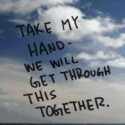
YK AM – You’ve Gotta Go THROUGH It
A few months ago, Spencer came home from preschool singing a song that I hadn’t heard for years. It’s one of those call and repeat songs, so repeat after me:
We’re goin’ on a bear hunt,[1]
We’re going to catch a big one,
What a beautiful day
We’re not scared.
Uh oh – grass
Long wavy grass!
We can’t go over it,
We can’t go under it,
We’ve got to go through it!
Swishy Swashy – swishy swashy – swishy swashy –
The song continues as the children in the story meet one mildly frightening roadblock after another. A deep cold river, a dark creepy cave. They even find – GASP! – THE BEAR! These are definitely spooky for kids (and maybe even adults?). We’re reminded throughout – we’re not scared. Plus, maybe most importantly – we can’t go over it, and we can’t go under it. We’ve gotta go through it. It’s an American Folk Song for children, adapted into a book in 1989 by Michael Rosen.… yet it hit me in my kishkes when Spencer sang it to me this summer …while my mother was declining in hospice.
The words rang so true, and as deep as that Deep. Cold. River. in the song. It is a song presumably about an adventure, but what a safe way to learn there are moments in our lives which might be unexpected, and maybe even a little scary. Try as we might to want to get around them, we sure ain’t avoiding ‘em. We have to go through them. Can you imagine a more profound message to start learning as a 4-year-old?
As adults, this is still a really tough message to fully embrace. This past year has forced all of us – every single one of us – to wrestle with loss, frustration, sadness, loneliness, and isolation. We have stayed away from close relatives and friends for long periods of time, and we have all been isolated in our homes at various times, some for even longer due to being high risk. We’ve learned new behaviors and stopped old ones. Ever since the Pandemic of Covid-19 began more than six months ago, our world has changed in innumerable ways.
And I sincerely hope that you’ve allowed yourself the time and space to feel sad or angry about it. I’m sure there have been plenty of moments of joy sprinkled throughout. But have you let yourself cry? Or mourn the losses you’ve experienced? Or feel angry about events you’ve missed out on? We feel all of this loss because of the very real fear of illness, of the legitimate concern of getting or passing along the novel Coronavirus. We never would have guessed there were to be times when going grocery shopping would feel like a life or death choice. Due to these concerns, there have been so many heartbreaking consequences. Some of us have experienced the cruelty of having a loved one die, alone, in a hospital, since no one was allowed by their side.
Personally, as my mother lay dying of pancreatic cancer in the hospital, my three siblings and I were told that only one of us could visit her for a brief 20 minutes every other day. Thank goodness we counseled to bring her home to die in peace. And if your family experienced a lifecycle event – one of joy or sorrow – the added pressure of whether to hold it in person or how many people to include was often gut wrenching, as you rightly struggled to keep everyone safe. Funerals and shivas, which should be times filled with the comfort of friends and family were quiet…empty…and lonely. Happy events we may have been planning for a long time may have had to be cancelled or postponed until a time when it will be safe to, God-willing, have a large group of guests.
I don’t mean to just list all the ways in which we are depressed or frustrated, Instead, my intention is to give you permission to simply feel your feelings. Many of us push our negative feelings away so long, We don’t even realize we have them. But think about our Yizkor service this afternoon – how it gives us a time to allow our feelings of loss out in a contained setting so that we aren’t mourning nonstop. We know that we have at least four times a year to experience our grief either at home or in a safe, loving place surrounded by members of our synagogue community. As Dr. Henry Maudsley, a 19th century British Psychiatrist said, “A sorrow that has no vent in tears makes other organs weep,”[2] and so, it is critical that we give ourselves spaces and times to give our souls time to feel their various feelings.
There is no shame is admitting to depression, anxiety, or brokenness at this time or any time for that matter. Those of us who struggle with depression or anxiety in a good year May find our illnesses exacerbated by current events. Others who have never struggled with mental illness may be surprised to find themselves feeling symptoms of depression. The American Medical Association shared in an August article:
Former First Lady Michelle Obama revealed last week that she is one of those people battling “low-grade depression,” and she has lots of company. One in three Americans is dealing with symptoms of stress or anxiety, according to data from the U.S. Census Bureau and the National Center for Health Statistics. Speaking on “The Michelle Obama Podcast,” Mrs. Obama spoke about how COVID-19 and ongoing racial tensions across the country have affected her mental well-being. The following day, AMA Immediate Past President Patrice Harris, MD, MA, commended the former First Lady for her candor. “I thought it was important that Mrs. Obama talked about the fact that she’s had difficult days and had some days where she feels like she had a low-grade depression,” Dr. Harris said. “We’re talking about it [mental health], and that’s important.” Stigma has surrounded mental health for years, Dr. Harris said, particularly among African Americans and Latinx. Now, with increased stressors such as job loss and financial insecurity, as well as the physical distancing required to limit the spread of the coronavirus, the risk of depression and anxiety is even more prevalent. Having a recognizable figure such as Michelle Obama openly acknowledge her struggles is helpful to dispel stigma.
In our culture, we aren’t taught how to be sad very well. We are impatient with grief – and grief is a good word for what many of us are feeling for all the different kind of losses since the pandemic began. A book entitled, Death and Grief: A Guide for Clergy, shares, “Shortly after a funeral” for instance, “mourners are expected to ‘be back to normal.’ …Grief is something to be overcome rather than experienced…. The result of these kinds of messages is to encourage the repression of the griever’s thoughts and feelings. Refusing to allow tears, suffering in silence, and ‘being strong’ are thought to be admirable behaviors.”[3] And now we just multiply that exponentially for an entire world experiencing the coronavirus to see how we are all coping, or, rather, not quite coping.
In her book, Mourning and Mitzvah: A Guided Journal for Walking the Mourner’s Path Through Grief to Healing, Rabbi Anne Brener asks the reader if we have a good role model for mourning.
It has been exactly two months since my mom died. When I encountered this question, I realized I didn’t have a good role model for how to mourn. Thus, this has become very important to me – when you wonderful people have asked me how I’m doing, I’ve been fighting the cultural pressure to saying “I’m fine,” and, instead, I have tried to be honest – I’m not doing well, I’m quite sad. And it’s ok.
You might recall that young Jackie Kennedy, frozen in silent grief, was credited with showing great dignity in leading our nation through the trauma of her husband’s assassination. But in Mitzvah and Mourning, Rabbi Anne Brener wonders about the personal cost of Jackie Kennedy’s “dignified” and public grief, as well as the danger of a role model who did not shed a single tear. In later years, it was revealed that the President’s young widow would go out on a boat, where no one could hear her, and scream at the horror that had come into her life and the lives of her children.[4]
It’s healthy to allow the sadness of our experiences to come out – it is not weak, it is not dysfunctional, it is not going to destroy us. Rather, it strengthens us for later experiences and makes us more resilient.
On this day of “At-one-ment”, I wonder what we’d accomplish or experience if we took all that energy that we use to push away sadness or anger, and instead used it elsewhere. This afternoon, you’re invited to join Cantor Belinda and me at 3:30 for our Contemplative Afternoon Service, something brand new, which we’ve titled, “Kvetch, Comfort, and Courage.” We are hoping to provide some space for this sadness, as well as some time for deep breaths and comfort, all of which we need plenty of this year.
The sweet irony of the Bear Hunt song is that, during this time of Covid-19, some families throughout America have actually started putting teddy bears in their front windows so that other families can go on walks or travel in their cars to go on socially distant, real-life “teddy-bear hunts.” Just so that this time can be just a little less scary. Because we can’t go Over it. We can’t go Under it. We have to go THROUGH it. And we have no choice but to go THROUGH it together.
May we embrace the complexities of our current lives in a new way. May we allow ourselves to feel our feelings, to sit in the discomfort of our “new normals,” and to cry, rage, stomp our feet, reach out for a (safe) hug, stay in bed a little longer, take a long bath, meditate, color a mandala, call a friend, watch a funny movie, or whatever we need – when we need to.
May we do the work to allow our whole selves to be present in each moment, and to be the full souls that God meant us to be. Because that is what will allow us to get through it in the New Year.
Amen.
[1] Rosen, Michael and Helen Oxenbury. We’re Going on a Bear Hunt. Margaret K. McElderry Books. 1989.
[2] As quoted in Mitzvah and Mourning, by Rabbi Anne Brener, p. 46.
[3] Wolfert, Alan, Ph.D. Death and Grief: A Guide for Clergy. Muncie, IN: Accelerated Development, Inc. Publishers, 1988. p. 4.
[4] Brener, Anne. Mourning and Mitzvah. pp. 48-49.





